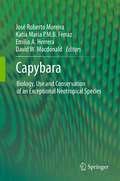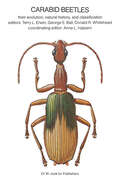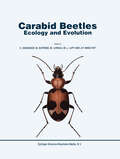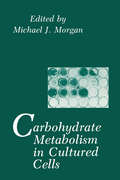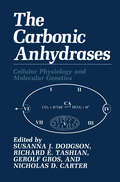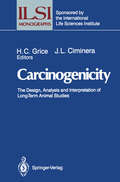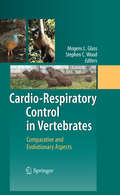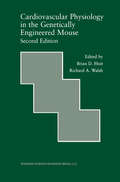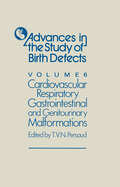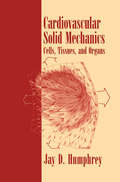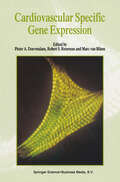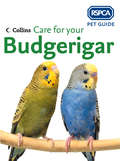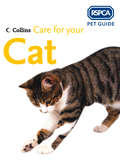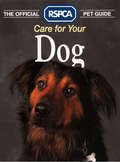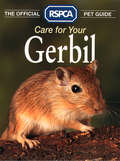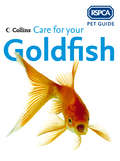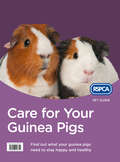- Table View
- List View
The Capture: The Capture (Guardians of Ga’Hoole #1)
by Kathryn LaskyIntroducing the newest heroes to children's fiction; the owls of Ga'Hoole. Meet Soren and his friends, the owls charged with keeping owldom safe. Based on Katherine Lasky's work with owls, this adventures series is bound to be a hit with kids. Join the heroic owls in the first of a series of mythic adventures.
Capybara: Biology, Use and Conservation of an Exceptional Neotropical Species
by José Roberto Moreira, Katia Maria P. M. B. Ferraz, Emilio A. Herrera and David W. MacdonaldThe capybara is the neotropical mammal with the highest potential for production and domestication. Amongst the favorable characteristics for domestication we can list its high prolificacy, rapid growth rate, a herbivorous diet, social behavior and relative tameness. The genus (with only two species) is found from the Panama Canal to the north of Argentina on the east of the Andes. Chile is the only country in South America where the capybara is not found. The species is eaten all over its range, especially by poor, rural and traditional communities engaged in subsistence hunting. On the other hand, in large urban settlements wildlife is consumed by city dwellers as a delicacy. The sustainable management of capybara in the wild has been adopted by some South American countries, while others have encouraged capybara rearing in captivity.
Carabid Beetles: Their Evolution, Natural History, and Classification
by T. L. Erwin George E. Ball D. R. Whitehead A. L. HalpernProceedings of the First International Symposium of Carabidology held at the Smithsonian Institution, Washington, D.C., August 21, 23 and 25, 1976
Carabid Beetles: Ecology and Evolution (Series Entomologica #51)
by J-P. Maelfait K. Desender M. Dufrêne M. Loreau M. L. LuffCarbohydrate Metabolism in Cultured Cells
by M. J. MorganIt is perhaps obvious to any student of Biology that the discovery of chemical processes in whole organisms has usually preceded the elucidation of the compo nent steps. However, it is perhaps less obvious that the unravelling of the se quences in which those chemical steps occur in living matter, of the precise mechanisms involved, and of the manner in which they are regulated, would have been achieved neither by the study of intact plants and animals nor even of extracts derived from them. Our ability to understand the nature and regulation of metabolism rests on two main premises: the postulate that life processes can indeed be validly investigated with individual cells and cell-free extracts, and the thesis that there is an essential "unity in biochemistry" (as Kluyver put it, 60 years ago) that enables events in one organism to be legitimately studied in another. Of particular utility in this latter respect has been the use of cultures of single-celled organisms, growing in defined media-especially prokaryotes, such as Escherichia coli, and eukaryotes, such as Neurospora and Sac charomyces sp. , to which both biochemical and genetical techniques could be applied. It was, of course, Pasteur's observations of bacterial fermentations that first overthrew the belief that oxygen was essential for all energy-yielding pro cesses: his recognition that "La fermentation . . . . . c' est La vie sans air" laid the foundations of our knowledge of glycolysis.
The Carbonic Anhydrases: Cellular Physiology and Molecular Genetics
by N. D. Carter S. J. Dodgson G. Gros R. E. TashianAs we approach the twenty-first century the problems of industrialization are evident: we find there is a greenhouse effect, the ozone layer is being depleted, the rain is acidified, and there is a terrible problem of increasing C0 concentrations in the atmo 2 sphere. The carbonic anhydrases are a unique family of enzymes that solve these problems in the human body: they are responsible for converting C0 (a gas) to 2 HC0-, which is the biggest intracellular buffer, with a concomitant decrease in a 3 hydroxyl ion. Globally, the functions of the carbonic anhydrases in photosynthesis in rain forests and in the algae and plankton that cover our oceans indicate that they are also of utmost importance in the maintenance of the acid-base balance on our planet. Although the whole field of C0 metabolism is enormous and still rapidly 2 expanding, because of the research interests of the editors this book is mainly concerned with mammalian carbonic anhydrases. However, if the interested reader intends to purify carbonic anhydrases from nonmammalian sources, Dr. Cheg widden has provided the necessary information in Chapter 7. The carbonic anhydrases were first discovered in 1933; until1976 there were thought to be only two isozymes. Since then CA ill, IY, V, VI, and Vll have been discovered and well characterized. There is, of course, no reason to believe that we have found them all.
Carcinogenicity: The Design, Analysis, and Interpretation of Long-Term Animal Studies (ILSI Monographs)
Critical issues in the design, evaluation and interpretation of long-term animal carcinogenicity studies are addressed in this volume. The presentations are by top pathologists, toxicologists and statisticians in the USA, Canada and Europe, representing industry, academia and regulatory agencies. The discussions involve controversial as well as conventional issues and are presented from statistical and biological or toxicological perspectives. Although more work has been done and published on long-term animal carcinogenicity studies than in any other phase of chemical or drug safety assessment, many issues still remain unresolved. Some solutions have been proposed, but in many instances they have not proven to be completely remedial. This volume continues important discussion of these issues and proposed solutions, and should be of interest to scientists engaged in long-term animal carcinogenicity testing.
Cardio-Respiratory Control in Vertebrates: Comparative and Evolutionary Aspects
by Mogens L. Glass Stephen C. WoodHopefully, this book will be taken off of the shelf frequently to be studied carefully over many years. More than 40 researchers were involved in this project, which examines respiration, circulation, and metabolism from ?sh to the land vertebrates, including human beings. A breathable and stable atmosphere ?rst appeared about 500 million years ago. Oxygen levels are not stable in aquatic environments and exclusively water-breathing ?sh must still cope with the ever-changing levels of O 2 and with large temperature changes. This is re?ected in their sophisticated count- current systems, with high O extraction and internal and external O receptors. 2 2 The conquest for the terrestrial environment took place in the late Devonian period (355–359 million years ago), and recent discoveries portray the gradual transitional evolution of land vertebrates. The oxygen-rich and relatively stable atmospheric conditionsimpliedthatoxygen-sensingmechanismswererelativelysimpleandl- gain compared with acid–base regulation. Recently, physiology has expanded into related ?elds such as biochemistry, molecular biology, morphology and anatomy. In the light of the work in these ?elds, the introduction of DNA-based cladograms, which can be used to evaluate the likelihood of land vertebrates and lung?sh as a sister group, could explain why their cardio-respiratory control systems are similar. The diffusing capacity of a duck lung is 40 times higher than that of a toad or lung?sh. Certainly, some animals have evolved to rich high-performance levels.
Cardiology for Veterinary Technicians and Nurses
by H. Edward DurhamCardiology for Veterinary Technicians and Nurses is a comprehensive resource for veterinary technicians and nurses working with cardiovascular patients in veterinary practice. Offers a complete reference to veterinary cardiology targeted at veterinary technicians and nurses, summarizing fundamental knowledge on cardiovascular disease Covers dogs, cats, horses, ruminants, and camelids Provides information ranging from introductory to advanced for a thorough guide to cardiac conditions Presents detailed procedures for common cardiac catheterization techniques, including supplies required Includes photographs and illustrations to depict the concepts described
Cardiology for Veterinary Technicians and Nurses
by H. Edward Durham Jr.Cardiology for Veterinary Technicians and Nurses is a comprehensive resource for veterinary technicians and nurses working with cardiovascular patients in veterinary practice. Offers a complete reference to veterinary cardiology targeted at veterinary technicians and nurses, summarizing fundamental knowledge on cardiovascular disease Covers dogs, cats, horses, ruminants, and camelids Provides information ranging from introductory to advanced for a thorough guide to cardiac conditions Presents detailed procedures for common cardiac catheterization techniques, including supplies required Includes photographs and illustrations to depict the concepts described
Cardiology of the Horse
by Celia M. Marr I. Mark BowenCardiology of the Horse is a multi-author, contemporary reference on equine cardiology. The first section reviews the physiology, pathophysiology and pharmacology of the equine cardiovascular system. The second section describes diagnostic methods from basic to specialist examination skills and the third section addresses the investigation and management of common clinical problems using a problem-orientated approach. Suitable for students, general and specialist practitioners and teachers.An up-to-date account of current clinical practice in equine cardiology covering: - recent developments in research and practice - problem-orientated approaches helpful to both general and specialist practitioners - clinical management of specific groups from foals and racehorses to geriatric patients - cardiac problems related to exercise, anaesthesia and intensive care - companion DVD of clinical cases with extensive footage combining theory and clinical practice: - echocardiograms - heart sound and murmurs - ECGs - radiography - pathology - extensive linking to the DVD, integrating fundamental principles and diagnostic data with information on clinical management of specific problems
Cardiovascular Disease in Companion Animals: Dog, Cat and Horse
by Wendy A. Ware John D. BonaguraThis new edition of Cardiovascular Disease in Companion Animals, authored by two leading experts in the field, now covers the horse as well as the dog and cat. The comprehensive, superbly illustrated book has been completely revised and expanded from the original Cardiovascular Disease in Small Animal Medicine. Five key sections provide clearly written overviews of normal cardiovascular structure and function, pathophysiologic derangements and their manifestations, clinical cardiology testing and interpretation, and extensive guidance for cardiovascular disease diagnosis and management. A broad collection of clinical images, graphics, tables, diagrams, and a Summary Drug Tables for each species enhances the book’s utility as a practical clinical resource. Up-to-date references support the focus on cardiovascular diseases and reflect important developments in veterinary cardiology and practice. A valuable companion website contains videos and additional images to enhance each chapter. Since first publication in 2007, Dr Ware’s authoritative yet user-friendly guide to cardiovascular diseases in veterinary practice has been widely praised. This book contains even more illustrations of the highest quality. Coverage also includes diagnostic considerations for various clinical problems, procedures and techniques for patient evaluation, and detailed management strategies for congestive heart failure, arrhythmias, and other complications of cardiovascular disease. This second edition is a must-have for veterinary practitioners, students, interns, residents, and others with an in-depth interest in veterinary cardiology.
Cardiovascular Disease in Companion Animals: Dog, Cat and Horse
by Wendy A. Ware John D. BonaguraThis new edition of Cardiovascular Disease in Companion Animals, authored by two leading experts in the field, now covers the horse as well as the dog and cat. The comprehensive, superbly illustrated book has been completely revised and expanded from the original Cardiovascular Disease in Small Animal Medicine. Five key sections provide clearly written overviews of normal cardiovascular structure and function, pathophysiologic derangements and their manifestations, clinical cardiology testing and interpretation, and extensive guidance for cardiovascular disease diagnosis and management. A broad collection of clinical images, graphics, tables, diagrams, and a Summary Drug Tables for each species enhances the book’s utility as a practical clinical resource. Up-to-date references support the focus on cardiovascular diseases and reflect important developments in veterinary cardiology and practice. A valuable companion website contains videos and additional images to enhance each chapter. Since first publication in 2007, Dr Ware’s authoritative yet user-friendly guide to cardiovascular diseases in veterinary practice has been widely praised. This book contains even more illustrations of the highest quality. Coverage also includes diagnostic considerations for various clinical problems, procedures and techniques for patient evaluation, and detailed management strategies for congestive heart failure, arrhythmias, and other complications of cardiovascular disease. This second edition is a must-have for veterinary practitioners, students, interns, residents, and others with an in-depth interest in veterinary cardiology.
Cardiovascular Physiology in the Genetically Engineered Mouse (Developments in Cardiovascular Medicine #238)
by William H. Isbell Helaine SilvermanThe enormous advances in molecular biology and genetics coupled with the progress in instrumentation and surgical techniques have produced a voluminous and often bewildering quantity of data. The need for a second edition of Cardiovascular Physiology in the Genetically Engineered Mouse is underscored not only by these rapid advances, but by the increasing numbers of scientists who have focussed their research on genetically engineered mice. It is the primary objective of this second edition to interpret critically the literature and to provide a framework for the enormous amount of information in this burgeoning field. As in the first edition, the monograph serves as a practical guide for the investigator interested in the functional methods used to characterize the murine cardiovascular phenotype. However, this guidebook is a more comprehensive text than its predecessor; although the major objectives enumerated in the first edition have not substantially changed, they have been refined in keeping with the increased sophistication of the molecular biologist, geneticist, and physiologist in each other's discipline. Each chapter has been expanded and updated, richly enhanced with original tables and figures, and in many cases, extensively rewritten. Eight chapters written by internationally recognized experts have been added; this represents a 43 % increase from the first edition.
Cardiovascular, Respiratory, Gastrointestinal and Genitourinary Malformations (Advances in the Study of Birth Defects #6)
by T. V. N. Persaud M. P. PersaudBirth defects have assumed an importance even greater now than in the past because infant mortality rates attributed to congenital anomalies have declined far less than those for other causes of death, such as infectious and nutritional diseases. As many as 50 % of all pregnancies terminate as miscarriages, and in the majority of cases this is the result of faulty intrauterine development. Major congenital malformations are present in at least 2 % of all liveborn infants, and 22 % of all sti1Ibirths and infant deaths are associated with severe congenital anomalies. Not surprisingly, there has been a great proliferation of research into the problems of developmental abnormalities over the past few decades. This series, Advances in the Study of Birth Defects, was conceived in order to provide a comprehensive focal source of up-to-date information for physi cians concerned with the health of the unborn child and for research workers in the fields of fetal medicine and birth defects. The first four volumes featured recent experimental work on selected areas of high priority and intensive investigation, including mechanisms of teratogenesis, teratological evaluation, molecular and cellular aspects of abnormal development, and neural and behavioural teratology. It seems logical and timely that the clinical aspects should now be presented. Accordingly, leading experts were invited to review a broad range of common problems from the standpoint of embryology, aetiology, clinical manifestations, diagnosis and management. This volume deals with cardiovascular, respiratory, gastrointestinal, and genitourinary malformations.
Cardiovascular Solid Mechanics: Cells, Tissues, and Organs
by Jay D. HumphreyThis text presents a general introduction to soft tissue biomechanics. One of its primary goals is to introduce basic analytical, experimental and computational methods. In doing so, it enables readers to gain a relatively complete understanding of the biomechanics of the heart and vasculature.
Cardiovascular Specific Gene Expression (Developments in Cardiovascular Medicine #214)
by Pieter A. Doevendans Robert S. Reneman Marc Van BilsenImproving our insights into the genetic predisposition to cardiovascular disease is one of the most important challenges in our field in the next millennium, not only to unravel the cause of disease but also to improve the selection of patients for particular treatments. Nowadays, for example, subjects with a cholesterol above a particular plasma level are exposed to a cholesterol lowering regime based upon the beneficial outcome of epidemiological studies which include subjects not prone to the disease, despite a plasma cholesterol above the accepted level. Identification of the patients who are genetically predisposed to the consequences of this disorder will reduce the number of subjects unnecessarily treated and, hence, the costs of health care. Because in most cardiovascular diseases the genetic component is a consequence of more than one gene defect, only limited progress has as yet been made in identifying subjects genetically at risk. For example, in hypertension only in less than 10% of the patients the genetic defect has been identified. It has been known for quite some time that in heart and blood vessels fetal genes are as high blood pressure and upregulated or induced when they are exposed to such disorders ischemia. Little is known about the function of these genes in the cardiac and vascular adaptation to these disorders; only guesses can be made.
The Care and Feeding of an IACUC: The Organization and Management of an Institutional Animal Care and Use Committee, Second Edition
by Whitney Kayla Petrie Sonja Lea WallaceMaintaining its user-friendly approach, this new edition of a bestseller summarizes information necessary for the effective and efficient operation of an IACUC. The book covers training programs and discusses professional certifications for IACUC administrative and animal care staff. It provides pointers to principal investigators, discusses interactions between IACUCs and other compliance panels, and addresses occupational health and safety programs and the role they play in the overall animal care and use program. It also delves deeply into bioethics to explore how IACUCs can ensure that each proposal to use animals in research includes an ethical review.
The Care and Feeding of an IACUC: The Organization and Management of an Institutional Animal Care and Use Committee, Second Edition
by Whitney Kayla Petrie Sonja Lea WallaceMaintaining its user-friendly approach, this new edition of a bestseller summarizes information necessary for the effective and efficient operation of an IACUC. The book covers training programs and discusses professional certifications for IACUC administrative and animal care staff. It provides pointers to principal investigators, discusses interactions between IACUCs and other compliance panels, and addresses occupational health and safety programs and the role they play in the overall animal care and use program. It also delves deeply into bioethics to explore how IACUCs can ensure that each proposal to use animals in research includes an ethical review.
Care for your Budgerigar (RSPCA Pet Guide)
by RSPCAPublished in association with the RSPCA, the UK’s leading animal welfare charity, this practical family guide is full of expert advice on how to choose budgerigars and how best to look after them.
Care for your Cat (RSPCA Pet Guide)
by RSPCAPublished in association with the RSPCA, the UK’s leading animal welfare charity, this practical family guide is full of expert advice on how to choose a cat and how best to look after it.
Care for your Dog (The Official RSPCA Pet Guide)
by RSPCASponsored by the Royal Society for the Prevention of Cruelty to Animals, the RSPCA Guides give you the most helpful and accurate advice on how to best care for your pet.
Care for your Gerbil (The Official RSPCA Pet Guide)
by RSPCASponsored by the Royal Society for the Prevention of Cruelty to Animals, the RSPCA Guides give you the most helpful and accurate advice on how to best care for your pet.
Care for your Goldfish (RSPCA Pet Guide)
by RSPCAPublished in association with the RSPCA, the UK’s leading animal welfare charity, this practical family guide is full of expert advice on how to choose a goldfish and how best to look after it.
Care for Your Guinea Pigs: Find Out What Your Guinea Pigs Needs To Stay Happy And Healthy (RSPCA Pet Guide)
by RSPCAPublished in association with the RSPCA, the UK’s leading animal welfare charity, this practical family guide is full of expert advice on how to choose a guinea pig and how best to look after it.

